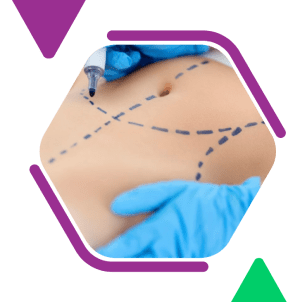Liposuction

Liposuction
In women, the creation of smooth and well-defined curves always improves their figures. As surgeons, we aim to improve the shape of our patients, but the results of our efforts are closely linked to the realistic expectations of each patient rather than unrealizable ones.
In males, a more angular and muscular shape is sought, paying attention to the definition of the abdomen and chest wall muscularity. Improvement in shape and figure generally makes patients feel more comfortable about themselves, enabling more versatility in wearing different clothes, sporting fashions, and/or swimwear.
It has established itself as the most valuable body-contouring plastic surgical procedure available, and the demand for it is not abating. Improved instrumentation and anesthetic techniques have facilitated better and upgraded results since the introduction of the technique 30 years ago.
Indication:
The optimal patient is one who has completed diet and exercises but still has localized areas of fat deposition. In men, these areas are the abdomen, male breast, and love handle area. In females, these areas are the inner thigh, outer thighs, hips, and abdomen. Obese patients should be accepted with proper counseling, explaining that liposuction is a procedure for body sculpting and not for weight reduction. Hence, expectations should be realistic with a proper understanding of the limitations.
What is safe liposuction?
It is generally accepted that large-volume liposuction is anything over 5000 mL of fat removal, and that greater volumes of aspiration are associated with increasing complication rates.
Machines
- Normal suction machine which generates about 30 mmHg negative pressure.
- Ultrasonic liposuction Machines.
- Power-assisted liposuction machine.
- Manual with syringe cannula.
Cannulas
There are various cannulas of different sizes ranging from 1 mm to 6 mm and in different shapes with varying tips.
Anaesthesia
It can be done under general, regional, or local infiltration with IV sedation.
Dressing, Compression, and Postoperative Management:
After the closure of all access ports with an absorbable suture, a gauze dressing is applied. Fluid leakage from the incisions overnight. Patients have to wear pressure garments for 2 to 3 months.
Adjunctive Measures Postoperatively:
Lymph drainage, massage, and ultrasound treatment by a qualified physiotherapist are recommended for persistent swelling and tissues that are woody, indurated, or bruised.
Complications
- Haematoma.
- Blood loss.
- Infection.
- Venous thrombosis, which are rare.
- Pulmonary embolism, which are very rare.
- Visceral perforation, again very rare.
- Seroma.
- Swelling.
- Bruising.
- Contour deformity.
- Loose skin which is not contracted.
- Numbness and paresthesia are usually self-limiting.
The pursuit of an aesthetically pleasing physique transcends gender boundaries, with individuals seeking to sculpt their bodies to align with their desired image. Liposuction emerges as a powerful tool in the realm of cosmetic surgery, enabling patients to address localized areas of fat deposition and achieve their ideal body contours. Whether it’s creating smooth curves in women or enhancing muscular definition in men, liposuction offers transformative results that instill confidence and improve quality of life.
Indications
- Localized Fat Deposits: It is ideally suited for individuals who have undergone diet and exercise regimes but struggle with stubborn pockets of fat in specific areas of the body. Common target areas include the abdomen, flanks (love handles), thighs, hips, buttocks, arms, and chin.
- Body Sculpting: It serves as a body-sculpting procedure rather than a weight-loss solution. Patients should have realistic expectations and understand that liposuction is not a substitute for healthy lifestyle habits but rather a complement to achieve desired body contours.
- Gender-Specific Concerns: In women, liposuction is often performed to create smoother curves and eliminate excess fat in areas such as the thighs, hips, and abdomen. In contrast, men may seek liposuction to enhance muscular definition in the abdomen, chest, and flanks, achieving a more angular and masculine physique.
Techniques
- Traditional: This technique involves the use of a suction machine to aspirate fat from targeted areas. The surgeon makes small incisions in the skin, inserts a thin cannula, and maneuvers it to break up and suction out fat cells.
- Ultrasonic : Ultrasonic liposuction utilizes ultrasound energy to liquefy fat cells before suctioning them out. This technique may be particularly effective for fibrous or dense fat deposits.
- Power-Assisted: PAL utilizes a specialized cannula that vibrates or oscillates to facilitate the breakdown of fat cells and enhance the efficiency of fat removal. This technique allows for more precise and controlled fat removal with less trauma to surrounding tissues.
- Manual : In manual liposuction, the surgeon manually manipulates a syringe cannula to aspirate fat cells. While less commonly used than other techniques, manual liposuction may be suitable for smaller treatment areas or delicate regions.
Safety Considerations
- Patient Selection: Ideal candidates for liposuction are individuals who are close to their ideal body weight, in good overall health, and have realistic expectations regarding the outcomes of the procedure. Obese patients may not be suitable candidates for liposuction, as it is not intended as a weight-loss solution.
- Volume Considerations: Large-volume liposuction, defined as fat removal exceeding 5000 mL, is associated with increased risk of complications such as hematoma, blood loss, infection, and thromboembolism. Surgeons must exercise caution and adhere to safe volume limits to minimize risks.
- Anesthesia: Liposuction can be performed under general anesthesia, regional anesthesia, or local anesthesia with intravenous sedation, depending on the patient’s preferences and the extent of the procedure. Anesthesia selection should be tailored to each patient’s medical history and comfort level.
Postoperative Management
- Dressing and Compression: Following liposuction, patients are typically advised to wear compression garments to minimize swelling and support the healing process. Dressings are applied to incision sites, and patients may experience fluid leakage in the initial postoperative period.
- Adjunctive Measures: Lymphatic drainage massage and ultrasound therapy by a qualified physiotherapist can help alleviate persistent swelling and promote tissue healing. Patients should follow postoperative instructions closely and attend follow-up appointments for optimal recovery.
Complications and Risks
- Immediate Complications: Immediate complications of liposuction may include hematoma, blood loss, infection, venous thrombosis, and pulmonary embolism. While these complications are rare, prompt recognition and management are essential to minimize risks.
- Late Complications: Late complications of liposuction may include seroma formation, persistent swelling, bruising, contour deformity, loose skin, and sensory changes such as numbness and paresthesia. Most of these complications are self-limiting and resolve with time.



